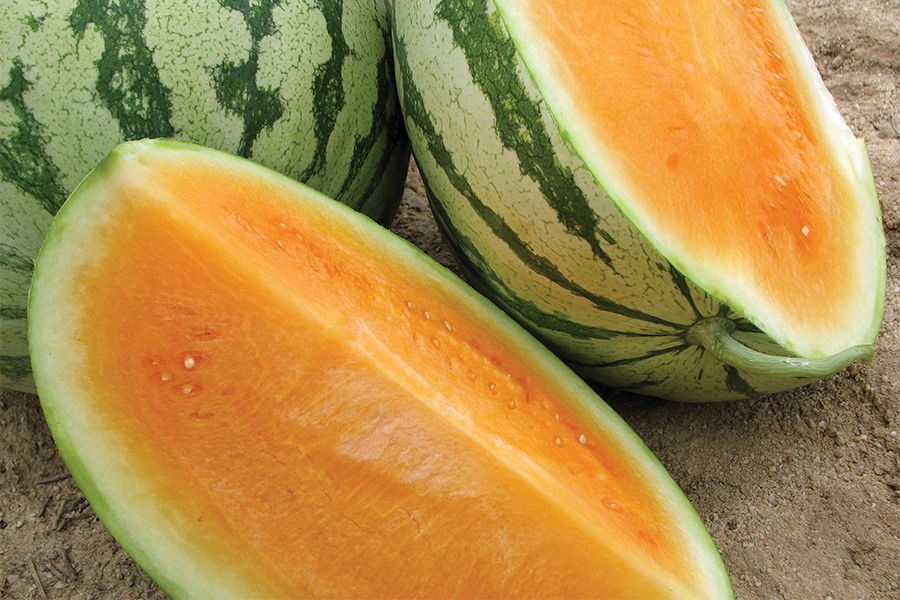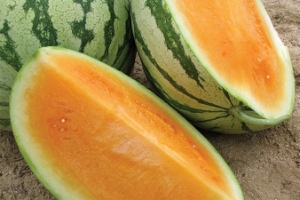
Orange Crisp
Orange Seedless
Very crisp and firm flesh. Yellow-orange flesh turns more orange as it matures and the taste improves with time. The melons hold up for a very long time in and out of the field. Don't pick too early!
| V46007 : Orange Crisp | ||
|---|---|---|
| Treatment | * Pkg Size | ** Price (USD) |
| Treated | 100 seeds | $52.90 |
| Treated | 500 seeds | $211.50 |
| Treated | 1M seeds | $361.50 |
|
* M = 1,000 ** US customer prices shown in USD. *** Canadian customers, please log in to see CA prices in USD. |
||
All watermelon require a signed waiver before we can ship your seed. Many waivers are vendor specific and you may need to sign multiple waviers if you are ordering more than one variety of watermelon.
Attributes
Growing Tips
-
The production capacity of triploid hybrid watermelons as well as their outstanding quality results from the adherence to specific production procedures. From germination of the seed through to harvest, triploids respond to careful and definite cultural procedures. The following suggestions are offered to growers in order that they might achieve the optimum results with triploid watermelons.
- Planting
-
Germination
The most common reasons for poor germination are over watering, incorrect watering, poor temperature control and shallow seed placement.
For growing transplants, the growing medium should be moist but not wet. Check moisture level by squeezing a handful of medium. Generally, if water drips from the medium it is too wet. Water the medium and allow it to dry for 12 to 24 hours. During this time, bring the temperature of the medium to 85-90° F (30-32° C). Before filling trays and seeding, stir the medium to ensure that it is evenly moistened. Start in the greenhouse and allow 28-35 days to get plants ready to transplant. Seedcoat adherence to cotyledons may be virtually eliminated by orienting the seed in transplant trays with the pointed end up at a 45 to 90 degree angle. Seeds should be planted between 0.5 inches to 0.75 inches deep in trays. This planting depth helps to prevent germinating seeds from pushing out of the media and maintains better uniformity of moisture around the seed. Place the seeded trays in a germination room for 48 to 72 hours or until germination begins (primed seed for 24 to 48 hours). The temperature of the room should be held at 85-90° F (30-32° C) and the relative humidity maintained between 90 and 100 percent. Once seedlings have begun to emerge, move the trays to the greenhouse. Maintain a temperature of approximately 80-85° F (27-30° C) until germination is complete. During the first week in the greenhouse, water only as needed to keep the planting medium moist. Do not over water, because this may destroy ungerminated seeds. Once the seedlings are established, temperature and watering can be adjusted to achieve sturdy plants.
Transplanting
Plant transplants 6-12 feet between rows with 36 inches between plants. Choose a pollinator that can be distinguished from the triploid at the time of harvest. As a general rule, direct field seeding of the pollenizer variety should be done on the same day the triploid seed is planted in the greenhouse. Small-fruited, icebox varieties usually flower earlier than standard watermelon varieties. If icebox varieties are to be used as the pollenizer, then direct seeding should be delayed a week to ten days. The diploid icebox pollenizer variety will frequently set fruit and stop producing male blossoms while the triploid variety is still producing female blossoms. Growers may make a second planting of a pollenizer 2 to 3 weeks after the initial planting to provide pollen for the late-developing female blossoms on the triploid variety. No consistent differences among any standard and icebox types in effectiveness of pollination have been noted. Icebox varieties used as pollenizers result in high early yields; standard varieties used as pollenizers result in high total yields.As a general rule, direct field seeding of the pollenizer variety should be done on the same day the triploid seed is planted in the greenhouse. Small-fruited, icebox varieties usually flower earlier than standard watermelon varieties. If icebox varieties are to be used as the pollenizer, then direct seeding should be delayed a week to ten days. The diploid icebox pollenizer variety will frequently set fruit and stop producing male blossoms while the triploid variety is still producing female blossoms.
Growers may make a second planting of a pollenizer 2 - 3 weeks after the initial planting to provide pollen for the late-developing female blossoms on the triploid variety. No consistent differences among any standard and icebox types in effectiveness of pollination have been noted. Icebox varieties used as pollenizers result in high early yields; standard varieties used as pollenizers result in high total yields.
Planting Guidelines - WatermelonApproximate Seeds per Pound:4,000 - 8,000 (large), 8,000 - 10,000 (small)Seeding Rate per Acre by Weight:5.1 - 5.1 oz (large), 2.6 - 4 oz (small)Seeding Rate per Acre in M (1,000):1.3 - 2.6 MSeeding Rate Seeds per 1,000 foot of Row:333Seed or Plant Spacing In Row:36"Seed or Plant Spacing Between Rows:72 - 144"Seed or Plant Spacing Depth:.5 - 1"Recommended Soil Temperature:80 - 95°FDays to Germination:8 - 12
- Management
-
For successful seedless watermelon production, an adequate bee population is especially important to transfer the pollen from the pollenizer variety to the seedless variety (seedless watermelons do not produce pollen). The pollenizer variety is normally planted in alternate, or every third row to ensure adequate pollen movement by the bees. At least eight visits to an individual flower of the seedless variety are necessary for adequate hormonal stimulation for normal fruit development. Scout fields every 7 days to monitor weed, insect, and disease pressure.
- Harvest
-
Ripeness is indicated by a cream to slight yellowing of the white background color of the part of the melon that rests on the ground. Drying of the stem tendril nearest the attachment point of the watermelon and green color tone of the rind are also indicators of ripeness but these vary with cultivar. Melons should be cut from the vine rather than pulled, twisted, or broken off.
- Storage
-
Store at 50 - 60ºF and at a humidity level of 90 - 95%. This will ensure a long shelf life.

